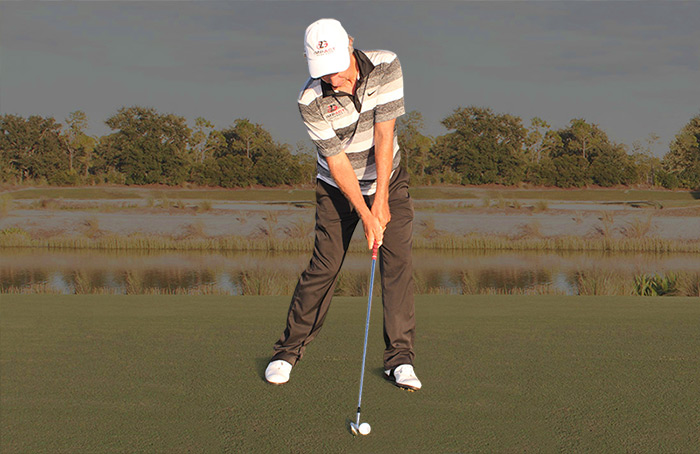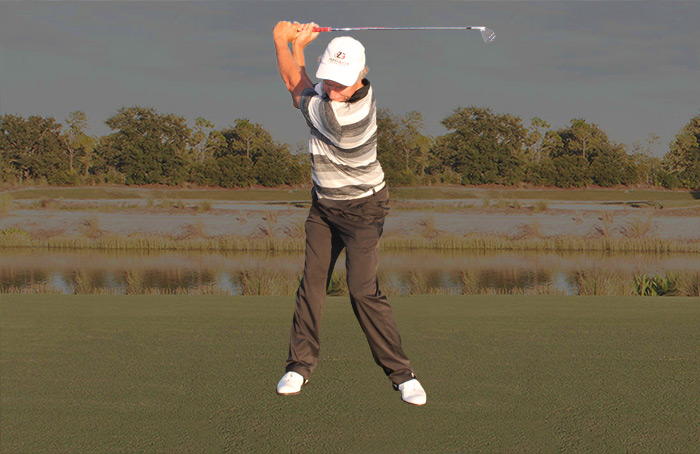
The most important moment in any golf shot is the strike, the 4/10,000 second that the clubface meets the ball. This strike we call “Impact”. Impact is golf’s moment of truth, where the rubber meets the road. Everything else pales in comparison to the importance of the strike.
The purpose of one’s swing or “style” of swing is to create Dynamic Impact; that is, the impact of the top touring pros (which are all virtually the same). Dynamic Impact is based on Bobby Clampett’s book, The Impact Zone and the Five Dynamics:
Definition/Explanation: The back of the hand, wrist and the forearm create or lie on a flat or straight plane at impact. Without the Flat Lead Wrist at impact, the proper geometry of the arc and the swing plane are not met. The Flat Lead Wrist allows maximum compression of the golf ball and insures the club and the lead arm and wrist move at the same pace and speed through the impact zone. This provides the structure needed to withstand the force of impact and allows players to strike down and through the ball, giving them the ability to achieve Dynamic Impact.


Definition/Explanation: All great players have a “four inch in front of the ball swing bottom!” The Swing Bottom is the deepest and widest part of the divot. The forward swing bottom promotes a forward lean of the clubshaft at impact, though the angle of the forward lean varies according to the club and shot.
Definition/Explanation: Though the “style” of the load differs between great players, all of them load the club at some point in the swing. The purpose of the backswing is to fully load the club, or load the club as much as possible, regardless of the length of shot. Thus, creating a backswing that is in a constant loading motion is optimal, while at the same time working naturally and in harmony with the pivot and body. What is loading? Loading is simply the cocking of the lead wrist. What the wrist cock loads is power, and it does so by adding leverage to the golf swing. The more a player loads the club through the lead wrist cock, the more power he/she can build into the swing. The load can be measured by the angle between the lead wrist, arm and clubshaft. The smaller the angle, the more the club is loaded; which creates more potential energy.


Definition/Explanation: Having the clubhead continually trail the body, arms, hands and clubshaft – right up to and through impact. All great players lag the club on the downswing. Without lag, good golf is virtually impossible. There is no such thing as having too much lag in the golf swing. Every shot in golf should retain the lag through impact. Lag is the downswing’s number one priority, concern and goal, until the player has swung well past the both-arms-straight, follow-through position. All players need to strive to sustain their lag through the impact zone with every club and on every swing, regardless of the size of the lag angle. Load your lag on the backswing and lag your load on the downswing.
Definition/Explanation: All great players deliver the club down a Straight Plane Line through impact, and this concept guides the motion of the swing from start to finish. The Straight Plane Line is the straight baseline of the inclined plane (aka, the “target line”). From a 3 foot putt to a 300 yard drive, players need to have the club shaft pointing at the straight plane line through impact. The most important time to be on plane is through the Impact Zone. Swinging on plane simply means that the clubhead and shaft approach the ball from inside the Straight Plane Line, then the clubshaft points directly at the line the instant it swings down past parallel to the ground until the moment the club makes contact with the golf ball. At that point the clubhead and shaft actually touch the Straight Plane Line for the first time since they did so at address. They then swing forward and up past the same parallel-to-the-ground alignment to the finish of the swing.
